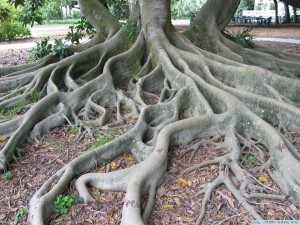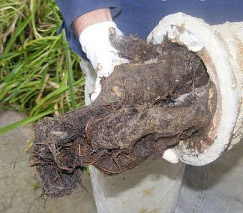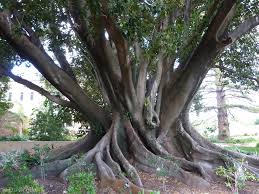Archives
Plumbing Terms
You’re going to want to be prepared for what your plumber has to say about the tree roots blocking your pipes. Maybe you’ve already talked to your plumber but you didn’t completely understand everything he said.
In any case, here’s a list of terms that may be basic to your plumber, but not so basic to you:
Backfill: Soil used to refill a trench that was dug up to excavate pipes.
Bedding: Material laid under a pipe that supports it and keeps the pipe from shifting in the soil.
Boundary Trap: A point of disconnection between your property/properties sewer and the local authority’s main. All your sanitary plumbing runs to this trap. It has a water seal to stop the smell from the sewer coming back up the line.
Cement Mortar Joint: A socket joint or pipe bend made out of cement.
Choke: A blocked drain.
Clearout: See I.O.
Conduit: A fancier word for pipe.
Defect: Decaying material, abnormality or obstruction in pipes that affects your plumbing.
Sanitary Drain: The plumbing (within your property line) that carries waste water away from your home or business. This type of drain includes any fitting or pipe that’s outside of the building.
House Drain: Plumbing within your sanitary drain system that carries waste water from sinks, toilets, equipment and tubs. This type of drain includes any plumbing that’s inside of the building.
Drainage Diagram: A map or plan of the approved sewer lines throughout your property; available from your local water authority, usually attached to a property ”contract of sale”.
Drainoscopy: A drainoscopy is the process of surveying your drainage pipelines with a high tech purpose-built camera. It really is the only way to see what is going on underground. A drainoscopy will show pipes, pipe joints, tree root penetrations, damage or even collapsed sections of pipe. A drainoscopy can be recorded and forwarded to you via email.
Helio: Plumbers over the age of 30 refer to this. See Drainage Diagram.
Infiltration: Unintended ground or storm water that makes it’s way into the sanitary/sewer drainage system, usually through cracks in pipes or joints, or tree root penetrations.
Installation: The creation of your network of pipes and fixtures or just your network of pipes and fixtures.
I.O. Inspection opening; a point of access into your house drains and branches.
Main: Usually owned and maintained by the local “Water authority”.
Pulling: Manually removing pipe obstruction by pulling a disk through the plumbing.
Rodding: Manually removing pipe obstruction using a system of jointed rods, like an electric eel.
Root Foam: A chemical foam mixture applied to pipes after mechanic root removal to prohibit future plant intrusion and reinforce pipes.
Root Penetration: Tree roots growing into plumbing, pipes, drains and sewers.
Rubber Ring Joint: A type of pipe joint seal that’s made out of chemically treated rubber circa; 1970-85
Sewer Main: The publicly owned pipes that carry waste water away from your property.
Sludge: Sort of the opposite of scum, this is pipe obstruction that sinks to the bottom of plumbing.
Spigot or Socket Joint: The male end of a pipe.
Sullage: Household waste water; specifically from sinks, kitchens and laundries.
Surcharge: Pipe or drain overflow cause by a combination of plumbing blockages and an abundance of rain. It could be from the main.
Surcharge Gully: An outside drain which may have a tap over. It is lower than your lowest floor drain, so that surcharge occurs here, not inside your home. It also has a water seal.
Tree roots in drains start out small
Do you know how small tree roots are when they enter your sewer drains?
Believe it or not, the tree roots that enter your drains through the small cracks in the pipe joints are finer than the hairs on your head or the purest Australian wool.
Once they find their way into the cracks and pipe joints they multiply.
Neighbours tree roots in your pipes
Tree roots growing under the fence is multiplying the number of over the fence disputes between neighbours.
As trees mature, their roots spread and sometimes, go under fences and into neighbouring properties’ sewer pipes.
Periods of no rain will see tree root systems spread in all directions in their search.
Many homeowners without a single tree on their property will still get a blocked drain caused by tree roots from their neighbours’ trees; sometimes 2 or more houses away. That is an inconvenience!
However, Vaporooter is a cost-effective way to stop tree roots in your drains and maintain neighbourly relationships.
Cutting tree roots makes them grow thicker and stronger
Did you know when you cut tree roots from your blocked sewer pipes, they grow back thicker and stronger?
You see, getting a blocked drain specialist to cut tree roots with high-pressure water or an electric eel is like pruning your hedge or rose bush, it encourages tree root regrowth.

Over a long period, when the tree roots in your sewer pipes grow back thicker and stronger, it reduces the time between cuts. And blocked drains occur more frequently!
Eventually, the roots that grow in through the small cracks and joints in your sewer pipeline will begin to damage or break your pipes.
So is the only remedy to dig up that section of pipe and carry out expensive repairs?
No! Find out more about Vaporooter.
Vaporooter Helps Strata Prevent $40,000 Sewer Replacement

Location: Clovelly, Sydney
Occupants: Mostly women over 40. 2 with teenage children.
Home: Block of four 2 bedroom flats 2 up, 2 down circa 1920
Trees in Vicinity: Tree lined Street, many large Hills Weeping Fig (Ficus Microcarpa Var.)
In total we have billed this client $9,772.00 for tree root cutting and repairs.
In March 2010, they finally indicated their interest in applying Vaporooter to control the tree roots in and around their sewer pipes.
The quote to apply Vaporooter is $1,586.00. This comes with a 12-month Guarantee.
The estimated cost to renew this sewer around both sides of the building and out to the sewer main in the street is estimated to be an astonishing $40,000.00.
The roots from the trees in this street are widespread and we have attended to blocked drains in houses and unit blocks up and down the street. The roots are getting stronger and without Vaporooter, a full sewer replacement will be the only (costly) alternative.
Some of the residents have indicated that instead of applying Vaporooter, they will lobby the Council to cut down the trees. That would change the entire streetscape and severely diminish their property value above the $40,000 sewer replacement and well beyond the preventative Vaporooter solution that is guaranteed to solve the problem.
This beautiful period block of flats, a 5 minutes walk from the beach is on a street lined with Hills weeping fig trees.
You know the kind; they produce the most beautiful summer shade with birds attracted to the fruit. The branch canopy stretches right across the street. But, so does the root system of these magnificent specimens.
We were first called to this property to attend a blocked drain in May 2005. The problem was tree roots from the specimens on the public footpath at the front of the property. The ground floor flats were the worst affected. Not only did their toilets back up when they flushed them, but when the flats upstairs flushed their toilet, that also came up and sometimes overflowed in the ground floor toilets.
That’s called The U-Tube (poo-tube) effect!
We recommended to the owner occupiers that Vaporooter would control the tree roots in their sewer. They declined to take up the offer.
In the 5 years since, we have attended to this sewer blocked by tree roots 7 times. We have carried out excavations to repair sections of drainage damaged by this aggressive tree root system. This unfortunately includes costly and inconvenient weekend and after hours callouts.
Stop Tree Roots in Pipes: Client Testimonial
Just in via email…..
Dear Dave and Leigh,
Thank you for doing the Vaporooter treatment this morning, it gives me considerable peace of mind.
As you will recall we had experienced some nasty sewer blockages previously, up to two a year, due to an invasive ficus vine spreading its tree roots into our pipes. The sewer line passes under a slab floor and access to the pipes is virtually impossible without major invasive works; Vaporooter seemed like a good option.
Once the blockage had been thoroughly cleared, you applied the treatment.
Today’s was the third annual re-treatment and I am happy to tell you that we have had no trouble whatsoever with the drains. The treatment has been successful and has avoided a costly and invasive repair job.
How Blocked Drains Happen
Sewer and drain pipes may not be very attractive to you, but tree roots love them. Tree roots are lured towards your pipes because of condensation. Moisture builds up around the pipes, more so in summer because the water in the pipes is much cooler than the surrounding environment . Thirsty tree roots lock onto the trail of dampness and creep toward your pipes.
The roots will grow along the pipes until they reach a crack, they may even pry open a loose joint. Once the pipe is breached, the root will grow into it to take advantage of the nutrient-rich material inside.
As the root continues to infiltrate the pipe it grows a bundle of thin root-masses. These masses make the blockage worse by trapping kitchen grease, food oil, and large pieces of drain debris such as toilet paper.
The tree roots will eventually exert so much pressure on the pipe that they will simply destroy the section that they have grown into. The pipe may crack or burst from the outside, or the pressure of the roots on the outside could cause the pipe to collapse in on itself.
Tree roots are not your everyday drain blockage. Most blockages can be quickly cleaned out by your local plumber. The blockages caused by roots that grow into pipes are much more complicated. Even if a plumber is able to eel out the blockage, there will still be damage to the line.

5 Ways to Prevent Blocked Drains
These simple measures will go a long way to prevent roots infiltrating and destroying your sewer pipes
-
- Use pipes made of Polyvinyl chloride (PVC) for new and replacement drains. PVC pipes are strong enough to repel the tree roots. Experts agree that PVC is the best material for reducing the risk of tree root blockages.
- Don’t plant trees near pipes. This seems simple enough, but many home and business owners don’t realize what constitutes as ‘near’ when we’re talking tree roots. Many Australian trees have roots that have an incredibly wide spread.
- Pick proper foliage. Eucalyptus, for example, can have root systems that spread out as little as 6 metres. Hills Weeping Fig, on the other hand, can have a root spread up to 60 metres.
- Maintain your pipes. Wear and tear, cracks, and leaks can cause nutrient-rich water to seep into the soil around your pipes. This attracts tree roots straight to your pipes.
- Routinely check and clear your sewer drain. Though roots can be attracted to any type of water-bearing line, they are most often lured towards sewer drains. An expert plumber and drain cleaner can come by and clear roots out of your pipes before they become a big problem.
Compare Vaporooter and Stop Tree Roots in Drains.
Blocked drains fixed… Free! What your Plumber doesn’t know
Does your home get blocked drains caused by tree roots? What if I gave you a written guarantee. We’ll fix your blockage for FREE! It sounds crazy, but its true!
It’s a simple process that less than 5% of Australian maintenance plumbers know about. In fact, plumbers don’t want you to know about it ’cause it Stops Tree Roots in Drains. It’s called Vaporooter and it works.
We protect over 328 families who got blocked drains 3-4 times a year before Vaporooter was introduced. Their pipes were blocked by tree roots. Not anymore!
Check out these case studies and learn a little more.

No more Blocked Drains?
Did you know……….
85% of all blocked sewer drains are caused by tree roots?
Simply put, there is a way to prevent blocked drains from happening ever again.
It’s easy, it’s safe and it Works!
It’s called Vaporooter


